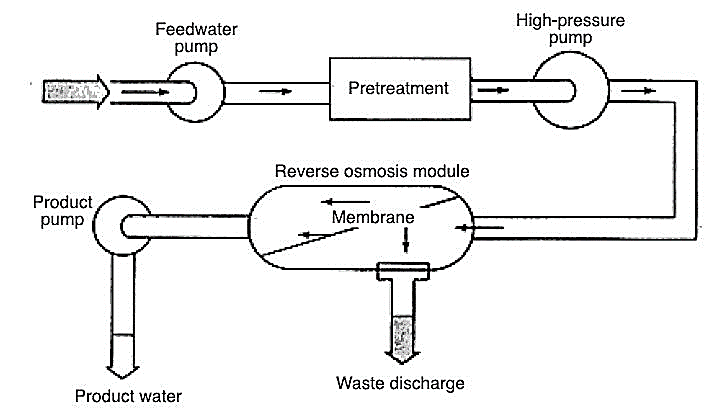
Seawater Desalination with Reverse Osmosis Plant
All Reverse Osmosis crops are mainly Desalination Crops but desalination is staying referred to sea water Generally.As sea water has very superior TDS requires pretty large force to drive sea h2o through membranes that happen to be various then brackish water membranes.
Reverse Osmosis Plant Information:
A reverse osmosis plant is usually a producing plant, the place h2o is purified and desalinated by forcing h2o by way of a membrane, ordinarily known as a reverse osmosis method. Water produced by plant RO might be used for a number of functions like desalination, wastewater therapy, as well as the reclamation of dissolved minerals.
RO Plant Description
An average ingesting drinking water RO plant technique calls for six KW several hours of energy to desalinate 1 cubic meter of drinking water. Reverse osmosis drinking water plants needs many different pre-remedy methods including softening, DE chlorination, and anti-scale procedure. Pursuing pre-remedy, higher amounts of stress send h2o through a semi-permeable membrane, which retains all contaminants besides h2o.
RO Plant Layout
To enhance the effectiveness and life of the Reverse Osmosis plant, productive pretreatment in the feed h2o is required. Array of the correct pretreatment will improve efficiency and membrane everyday living by lowering:
Fouling
Scaling
Membrane Degradation
RO plant design is consisting of:
Deciding pretreatment need of Reverse Osmosis Plant
In the event the feed h2o has traces of hefty metals, it is extremely proposed to dose some chlorine to change the dissolved weighty metals to Actual physical kind, the media filter will filter the majority of it in the ro h2o purifier plant.
Reverse Osmosis Plant Selection of membrane
Membrane factors are a vital Component of RO plants. The proteins (generally polyamide) that makeup membrane aspects differ according to the ending clarity and intake h2o seawater or brackish h2o etc
Waterman engineers Australia RO plant for seawater desalination
Waterman Engineers in Australia has made a Reverse Osmosis (RO) plant for seawater desalination, which features a number of positive aspects about other desalination solutions. Below are a few key benefits of their RO plant:
Energy Performance:
When compared to other desalination procedures like thermal distillation, RO demands fewer Power. Waterman Engineers' RO plant utilizes advanced membrane technologies, permitting it to operate at lessen pressures and lower Over-all Strength usage.
Environmental Impact:
RO generates fewer brine discharge when compared to thermal strategies, reducing the impact on marine ecosystems. This aligns with Australia's center on environmental sustainability and conservation.
Higher Drinking water Purity:
The RO procedure successfully eliminates salts, minerals, and impurities, developing large-excellent freshwater that satisfies stringent ingesting h2o requirements. This reliability is vital for providing safe and clean up h2o to communities.
Modular Design and style:
Waterman Engineers' RO plant employs a modular layout, letting for scalability and adaptability. This is especially advantageous for regions with various h2o calls for, as modules is often additional or adjusted accordingly.
Reduced Footprint:
RO plants generally Use a smaller sized Actual physical footprint when compared to thermal desalination vegetation, which frequently have to have in depth infrastructure for heating and cooling procedures.
Fast Get started-Up and Shutdown:
RO vegetation is often started off and stopped comparatively immediately, allowing for for greater responsiveness to transforming drinking water demands and emergencies.
Lessen Chemical Use:
Not like some other desalination solutions, RO involves fewer substances for Procedure and cleansing, reducing chemical-related environmental considerations.
Regularity in Effectiveness:
The RO method is less delicate to feedwater good quality fluctuations than other solutions, making certain a more reliable overall performance eventually.
Value-Effectiveness:
When initial financial investment fees is usually considerable, RO vegetation are likely to obtain lower operational and routine maintenance costs Eventually when compared to thermal strategies.
Reverse Osmosis (RO) is often a drinking water purification course of action that takes advantage of a partly permeable membrane to remove ions, unwelcome molecules, and bigger particles from consuming h2o. By making use of stress to beat osmotic strain, it permits the passage of h2o molecules while rejecting contaminants, thereby manufacturing cleanse drinking water on just one aspect of the membrane and Desalination Plant Manufacturer concentrated impurities on the opposite.
The Functioning basic principle of the Reverse Osmosis (RO) plant requires making use of pressure to some saline Alternative to force water molecules through a semi-permeable membrane. This membrane will allow only water to move when rejecting salts, contaminants, and impurities, causing purified h2o within the permeate facet as well as a concentrated Alternative of contaminants around the brine side.
The benefits of Reverse Osmosis involve developing higher-good quality, clean water by eliminating contaminants, currently being efficient and cost-effective after a while, necessitating minimum chemical use, and currently being adaptable to various scales of operation from smaller property techniques to substantial municipal plants.
RO plants have changed Demineralisation (DM) vegetation mainly because they often provide a more successful and value-successful Remedy for h2o purification. RO systems Really don't need the regeneration substances that resin-dependent DM crops do and will eliminate a broader variety of contaminants, together with dissolved solids and microorganisms.
Waterman Engineers Australia most likely works by using Reverse Osmosis (RO) vegetation for seawater desalination by forcing seawater by way of a semi-permeable membrane to get rid of salt and various impurities. This method provides new, potable water from your ocean, addressing water scarcity and delivering a sustainable provide for a variety of desires.